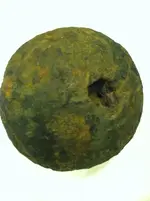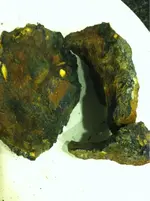I'm going to ask your pardon in advance, because your questions cannot be answered with a simple yes or no, nor with a single sentence. They are "complicated."
I've got nearly 40 years of experience with digging and studying historical artillery projectiles -- including "seacoast-dug" ones. (Check the "About me" info in my member Profile here at TreasureNet.)
The first thing we do is determine whether an iron ball is actually an artillery ball, or one made for civilian-usage purposes, such as a Sports Shot Put, or counterweight-ball, or Ornamental-ironwork (gatepost-top) ball, ball-bearings, mining industry ore-crusher ball, etc. The only solidly reliable way to answer the identification question is to very-precisely measure the ball's diameter and weight. Then we see if its measurements match up
precisely with any of the historical artillery balls in the US (and CSA) Ordnance Manual -- which gives the very-exact diameter and weight of every caliber of USA, CSA, British, and French cannonball, grapeshot ball, and cannon "Canister" (antipersonnel) ball used in America from the Revolutionary War to the end of the Civil War. (The precise diameter-&-weight data is given in the Ordnance Manual's "Shot Tables" charts.) If there's no
exact matchup there, the ball is not an artillery ball.
Unfortunately, your Outer Banks dug iron ball is far too corroded to get a precise enough measurement of its original diameter. We can never know with certainty whether or not it is an artillery ball.
You asked several questions, starting with:
> Can anyone give me an idea as to what type of shot this might have been?
The above information having been given... I will nonetheless add that in my professional opinion, it most-probably is a cannonball or grapeshot-ball.
Reasons:
1- The very unusual dig-location, where there was very little Ornamental ironwork, and no local use of ore-crusher balls. Also, no machinery which used a ball-bearing nearly 3 inches in diameter. Also, it is smaller than the smallest Sports Shot Put ball.
2- Its corroded size is slightly less than the correct diameter for a Colonial era "3-pounder caliber" cannonball, and a Colonial era or civil war era "32-pounder caliber" grapeshot-ball.
3- The "southern Outer Banks" saw a lot of pirate artillery activity in the Colonial era, and also a lot of warship-to-shore (and vice versa) artillery activity in that era
and during the civil war era. (For example, yankee Navy gunners literally blew the Confederates off the southern Outer Banks islands in the first year of the civil war.)
> The ball currently weighs in at just around 2 lbs, ~8.5 circumference, ~2.7 diameter.
The charts in the Ordnance Manual say a 2.7"-diameter cast iron ball should weigh slightly under 3.0 pounds. In addition to what is shown in the photos, your iron ball's loss of weight is explained by a version of corrosion which is typically found on seacoast-dug iron balls. Its iron body has been attacked by saltwater corrosion and also Tannic-Acid corrosion. The later is a condition we call "Graphitization." The Tannic-Acid (from decaying plant-leaves in nearby saltmarshes) literally leaches iron molecules out of the ball. The longer it is exposed to the Tannic-Acid, the more iron molecules are lost. What remains behind is the grey-black Graphite (carbon) molecules which were originally a natural component of the cast-iron. So, a "Graphitized" iron relic can retain most of its size, but will be significantly lighter than its size would ordinarly indicate it should weigh.
> The pictures are after about 30 hours in an electrolysis bath running at 6 amps [...]
> Did I over cook it in the electrolysis bath?
Yes. But being a total beginner, you can be forgiven.

"Graphitized" iron relics should NEVER be put through high-amperage electrolysis -- because the Graphitized skin of the iron will dissolve. That is part of the reason your ball is smaller than it originally was. Relics dug in "high-ground" are usually not graphitixed, and thus being put through 30 hours of 6-amp electrolysis won't harm them, and is in fact the correct amount of time -- although I prefer 1 to 2 amps, because it is "gentler."
Archeological artifact-preservation labs use Electrolysis on "low-ground" seacoast and shipwreck iron relics, but only at extremely low Milliamp levels of electricity.
> The other picture is to show what the ball was encased in; I was surprised at
> how thick it was; you'll notice the shell that was right up against it.
The reason the concretion was so uncommonly thick is that the soil which surrounded the ball got literally "petrified" by so much iron being leached out of it into the surrounding soil by the Tannic Acid.
Other readers who are relic-diggers, please note, the presence of unusually thick concretion on an iron relic is a strong indication that the relic's body has become "Graphitized" -- and thus should NOT be put into electrolysis. All you can do for cleaning a Graphitized iron relic is to
very gently tap off as much of the concretion as possible,
then
very lightly, gently smooth down the soft graphitized iron surface with a fine-guage file, dry the relic thoroughly, and quadruple-coat it with Polyurethane.
> How much size or mass does an object like this lose through electrolysis?
When an iron relic has NOT been subject to Graphitization by Tannic Acid, electrolysis will subtract only a little (if any) of the actual iron surface under the rust/dirt-concretion. The amount of iron surface removed by electrolysis will depend on how badly or slightly the iron has been "corrupted" by corrosion. In general, the thinner the rust/dirt-concretion is, the less the iron's surface has been corrupted. That is very much influenced by the soil-chemistry of the ground the relic is buried in -- such as sandy soil, clay soil, very-rocky soil, acidic soil, "neutral" soil, usually-dry soil, usually-wet soil, etc. Depth of burial is also an important factor. In general, the shallower an object is, the less corrosion will occur -- because deeper relics are more frequently exposed to groundwater.
> Does the thickness of the encasing give an idea as to the age?
In your ball's case, yes. Such a thick concretion takes
many decades to build up.
> Appreciate any insight, positive criticism [...]
I hope you will take my comments only as well-intended Education for you, not as criticism. Let me give you a sincere compliment, and encouragement. You made some quite-typical beginner's errors -- but you followed up on that by doing the smart thing, seeking "experienced knowlege" from longtime diggers (and oldtimer relic-ID experts), here in TreasureNet's What-Is-it forum.
So let me be among the first to say "Welcome to the forum."

May you have good fortune in your future diggings.
Speaking of which... I'll add that where you find one Colonial era or Civil War era relic, there are almost always more of them at that digging-location. But, please be careful you are not digging on ANY kind of government-owned land (not just a park). I mention this because I know a lot of the Outer Banks is US National Seashore property. A ranger warned me that using a metal detector to hunt for coins on the beach at the Pea Island Wildlife Preserve is illegal under Federal Law, because it is government-owned land. So are US National Forests, etc. (The same goes for State Property, and many County and City properties.)






 "Graphitized" iron relics should NEVER be put through high-amperage electrolysis -- because the Graphitized skin of the iron will dissolve. That is part of the reason your ball is smaller than it originally was. Relics dug in "high-ground" are usually not graphitixed, and thus being put through 30 hours of 6-amp electrolysis won't harm them, and is in fact the correct amount of time -- although I prefer 1 to 2 amps, because it is "gentler."
"Graphitized" iron relics should NEVER be put through high-amperage electrolysis -- because the Graphitized skin of the iron will dissolve. That is part of the reason your ball is smaller than it originally was. Relics dug in "high-ground" are usually not graphitixed, and thus being put through 30 hours of 6-amp electrolysis won't harm them, and is in fact the correct amount of time -- although I prefer 1 to 2 amps, because it is "gentler."